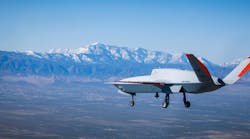SALINA -- Kansas State University Salina is one of the few places in the country that offers a degree and certificate program in the new and growing field of unmanned aircraft systems, so finding textbooks for courses was a challenge.
But not anymore.
The university's Kurt Barnhart, executive director of the Applied Aviation Research Center and head of the aviation department, and Eric Shappee, associate professor of aviation, have helped write and edit one of the first collegiate-level textbooks on unmanned aircraft systems, "Introduction to Unmanned Aircraft Systems."
They were joined by Stephen B. Hottman and Douglas M. Marshall. Hottman is deputy director of New Mexico State University's Physical Science Laboratory, and Marshall is the laboratory's division manager for unmanned aircraft systems regulatory and standards development.
"The book emerged when Professor Shappee and I were discussing the available textbooks for our new unmanned aircraft systems courses. There was very little available in the way of suitable material, so we decided to create it," Barnhart said.
"Most of what we found was out of date or didn't cover the information we wanted it to," Shappee said.
The textbook is designed as the students' first exposure to the field of unmanned systems and takes them from having little or no knowledge of the industry to being fluent in the terminology and familiar with the current challenges and issues surrounding the emerging field of study. The illustrated text also offers Web-based resources.
Chapters include current and proposed federal regulations, operational procedures, safety concerns, commercial and military applications, integration into the national airspace system, and the unmanned systems themselves.
Shappee will begin using the book in K-State's unmanned aircraft systems classes in January. He anticipates that the second edition will be released in less than two years to keep pace with the rapidly changing industry.
The book, published by Chemical Rubber Company Press, which primarily publishes texts in the engineering field, is available on Amazon.
Enrollment in the university's unmanned aircraft systems' bachelor's and certificate programs has soared. The bachelor's degree program was launched this fall and course enrollments are already capped.
Barnhart said one of the many factors that sets Kansas State University's program apart from the few others offered in the nation is that students actually get hands-on time learning to fly unmanned aircraft because of key authorization from the Federal Aviation Administration.
The university's unmanned aerial systems program, which also conducts research and testing of the systems, is one of the few civil entities granted a certificate of authorization within Class D airspace from the FAA. The authorization allows the program, based at the Salina Municipal Airport, to operate its unmanned aircraft in the national airspace system. It means students in the program can practice handing over control of an unmanned system to the next ground station, practice simulated lost-link procedures and experience scenario-based mission deployments. Such experience is important for using the systems in search-and-rescue operations and more.
"This gives Kansas State University an incredible advantage," Barnhart said. "There are a lot of institutions, particularly on the East Coast or in the eastern part of the country that are just restricted on where they can fly, so there's no opportunities for students to get hands-on experience getting these unmanned systems in the air. That's one of the advantages we have in the Great Plains."
The job market is wide open for students seeking careers in the field right now, said Josh Brungardt, director of the university's unmanned program.
"If a student wants to work for a manufacturer or military contractor and they're in the United States, they'll likely start out at $60,000-$65,000 right out of college," Brungardt said. "And if they want to do deployments and work for a contractor, they could earn up to $100,000 a year. It's a very lucrative career field for students."
